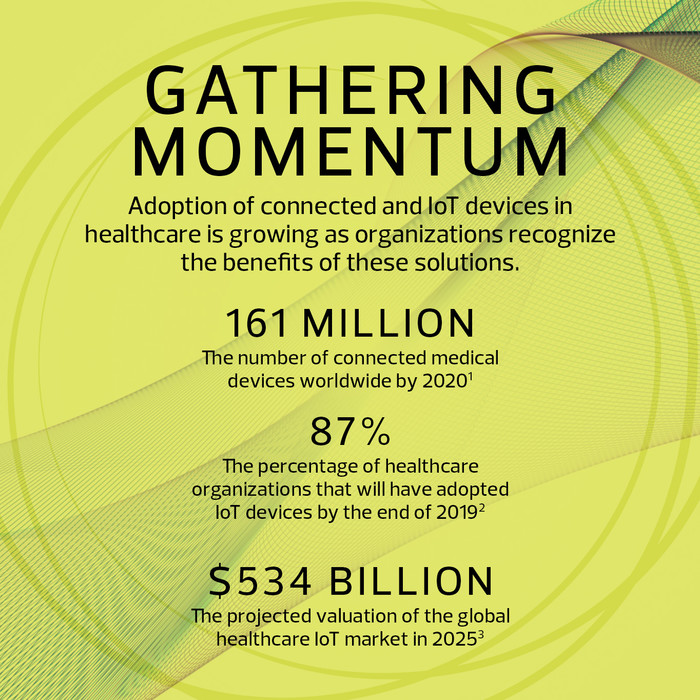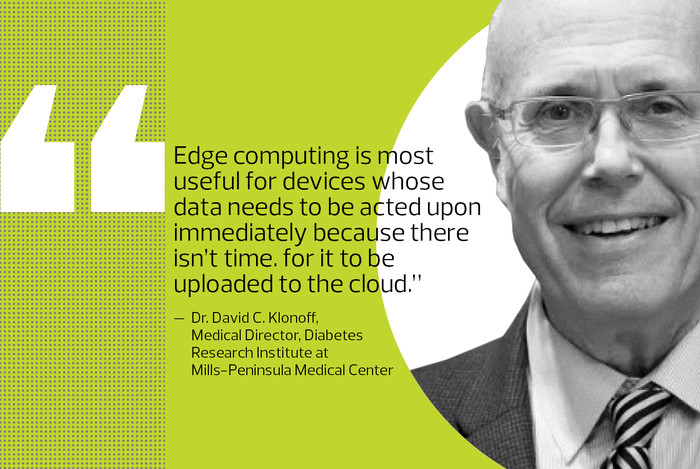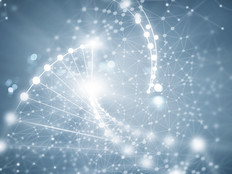The global market for Internet of Things medical devices is expected to exceed $500 billion by 2025, which will likely cause a major paradigm shift in healthcare IT. That’s because most computing now happens in on-premises data centers or, increasingly, in the cloud.
But analyzing data from a distance poses a number of risks — including bandwidth congestion, network reliability and latency — that could negatively affect health outcomes when seconds count. To address these concerns, forward-thinking healthcare organizations are moving to adopt edge computing, in which data is analyzed and acted upon at the point of collection, or on a nearby system situated between the connected device and the cloud (a concept known as “fog computing”).
HealthTech asked three experts to discuss the transformative power of edge computing. Our roundtable consisted of Dr. Shafiq Rab, senior vice president and CIO at Rush University Medical Center, one of three U.S. health systems to achieve the highest level of analytics maturity as determined by HIMSS; Dr. David C. Klonoff, medical director of the Diabetes Research Institute at Mills-Peninsula Medical Center and author of a report on how edge and fog computing affect diabetes patients; and Weisong Shi, a professor of computer science at Wayne State University and a researcher in the field of edge computing and connected health.
MORE FROM HEALTHTECH: IoT pushes healthcare organizations to boost their network capacity.
HEALTHTECH: What's driving the adoption of edge computing?
RAB: The key benefit of edge computing is the ability of devices to compute, process and analyze data with the same level of quality as data analyzed in the cloud, but without latency. This will decrease cost, increase efficiency and improve the patient experience, bringing us one step closer to autonomous care instead of merely automated.
KLONOFF: Edge computing and fog computing offer five advantages over cloud computing: greater data transmission speed; less dependence on limited bandwidth; greater privacy and security; greater control over data generated in foreign countries, where laws may limit use or permit unwanted governmental access; and lower costs, because as more sensor-derived data is used locally, less data needs to be transmitted remotely.
SHI: There are three huge benefits. The first will be to lighten the workload of medical practitioners by removing less important tasks, such as collecting and managing patient data. The second will be to make healthcare more affordable and accessible, especially for remote areas where medical care falls behind. A truck outfitted with edge computing devices, for instance, can visit isolated villages and provide advanced healthcare by connecting residents to telemedicine services.
The third benefit will be to stimulate medical technology advancement. As we all know, in the Big Data era, more data equals more opportunity. Edge computing will make it easier to manage and label data in a uniform and efficient way and will make it easier for colleagues to share data securely. This will enable technology development by allowing researchers to mine data that was otherwise unavailable in the past.
HEALTHTECH: Where will edge computing have its greatest practical impact?
RAB: Its greatest impact will be in the management of chronic disease. The combination of IoT and fast 5G cellular connections will enhance the delivery of at-home care and allow for continuous monitoring of patients for diseases such as diabetes and congestive heart failure.
KLONOFF: Edge computing is most useful for devices whose data must be acted upon immediately because there isn’t time for it to be uploaded to the cloud. An example would be intensive care unit sensors that require instantaneous analysis of data and execution of commands, such as closed-loop systems that maintain physiologic homeostasis. As sensors become more sophisticated, we’ll see similar closed-loop control of devices that monitor insulin levels, respiration, neurological activity, cardiac rhythms and GI functions.
Sources: 1forbes.com, “Prognosis for Health Care IoT: Six Predictions for 2019,” March 1, 2019; 2arubanetworks.com, “IoT Heading for Mass Adoption by 2019 Driven by Better-Than-Expected Business Results,” Feb. 28, 2017; 3Grand View Research, “IoT in Healthcare Market Worth $534.3 Billion By 2025,” March 2019
SHI: Emergency medical services is a potential scenario that could leverage onsite edge computing. Even with 4G LTE, connectivity in many cities is not always reliable. By enabling edge computing, crucial data can be transmitted from the ambulance to the hospital in real time, saving time and arming emergency department teams with the knowledge they need to save lives.
A multicampus healthcare system is another typical scenario. Right now, in many hospitals, there are hundreds of systems generating quite a large amount of data in different formats and levels of quality. Each medical practitioner has his or her own ways to label the data, making it difficult to use the information produced by different practitioners. Edge computing makes it possible to leverage collaborative machine learning to use all related data on multiple sites. And because such highly personal data can’t ever leave the hospital due to privacy concerns, this type of analysis must happen at the edge.
HEALTHTECH: What are the biggest challenges to implementation?
RAB: A key barrier is ensuring there’s enough bandwidth, which will require widespread implementation of 5G wireless networks. Other big challenges include the security of medical devices, the interoperability of devices with electronic health records and the adoption of AI. Of these, the most urgent challenge revolves around cybersecurity, while the costliest will be procuring sufficient bandwidth.
KLONOFF: Edge computing systems tend to be more secure than cloud computing, because the data does not travel very far from where it will be used — often just a few feet. This distributed edge architecture is also less prone to massive systemwide failures than a centrally controlled cloud computing system, and it’s less costly because it doesn’t require large investments in storage and data transmission infrastructure. But edge computing isn’t very good at storing large amounts of data, and its cost and speed advantages may decrease as 5G networks become more common.
SHI: The most urgent challenge is acceptance by healthcare professionals. Domain experts also have a critical role to play in designing edge computing systems for real healthcare use. The hardest problem to address is how to select appropriate edge computing tools for different healthcare scenarios. Because of privacy concerns, it is very hard to deploy open-source software directly into the healthcare system. Another challenge is determining who will pay for edge computing. For example, will the EMS charge more if they provide edge computing services on the way to the hospital?
HEALTHTECH: How should healthcare professionals prepare for edge computing?
RAB: There’s no substitution for education and collaboration. Medical professionals should be encouraged to embrace innovation.
KLONOFF: Healthcare professionals need to be ready to adopt new sensors that can provide information they can act upon in real time. But because the switch from having data transmitted to the cloud to having it processed on the edge will be seamless, it will probably go unnoticed by providers.
SHI: Edge computing in healthcare is domain-specific and needs support from healthcare organizations. It is necessary to work with domain experts to make sure that the system can really play in real life. Healthcare organizations will need to bring all stakeholders to the table to discuss their requirements and needs so they have a better chance of moving forward to applying edge computing to healthcare domains.
VIDEO: Discover the promise edge computing holds for healthcare.
HEALTHTECH: What will edge computing in healthcare look like in 20 years?
RAB: Predictive analytics will rule, and preventive care will be the norm. New markets will develop to cater to increasing demand for data-driven care, and new technologies — such as exoskeletons for frailer patients — will be needed as life expectancy increases. This will also raise new social issues, as we address the increasing gap between the haves and the have-nots.
KLONOFF: Patients will wear or carry multiple sensors; in some cases, these sensors will be implanted in their bodies and be powered by electricity generated by metabolism of glucose. We’ll analyze the output of these tiny implanted or wearable sensors using handheld or wearable devices and generate overall health scores based on a combination of reports from each sensor. In some cases, the sensors will trigger an automatic response from a device via edge computing. In other cases, the data will be collected and sent into the cloud for analysis, or a smaller localized version of the cloud known as fog computing.
SHI: The widespread adoption of healthcare IoT devices and edge computing will make citizens more aware of their health status. It will also make advanced healthcare resources available in remote areas via telemedicine. The ability for caregivers to regularly keep tabs on their patients will reduce the rehospitalization rate significantly. As collaborative edge computing and machine learning are able to preprocess data and generate meaningful analytics in real time, caregivers will spend less time collecting and analyzing data and more time caring for their patients.















